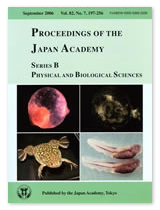About the Cover
Vol. 82 No. 7 (2006)
Upper left; A heart induced in vitro by activin treatment of animal cap cell of Xenopus laevis. Reaggregated animal cap cells differentiated into a heart-like beating structure when treated with 100 ng/ml activin. Myocardium-specific molecular markers were alsoexpressed in this explant. When transplanted into a host embryo, this explant could develop to a functional heart. These results showed that the activin treatment could induce animal cap cells to differentiate to the heart primordium.Upper right; Pronephric kidney tubules induced in vitro by the activin and RA treatments of animal cap cell of Xenopus laevis. A simultaneous treatment with 10 ng/ml activin and 0.1 mM RA could induce animal cap cells to differentiate to pronephric tubules at a high frequency. Immunohistological staining and electron microscopy revealed that these explants had the same structure and expressed pronephros-specific genes as normal pronephros. Lower left; An adult Xenopus laevis. Eggs can be obtained from female frogs by hormone-induced spawning at all times of the year and fertilized easily in vitro. Lower right; Spatial gene expression pattern of Ami. Ami mRNA expression was detected in the endothelium of the developing vasculature. (Please refer to the article by Okabayashi and Asashima in this issue for details.)




